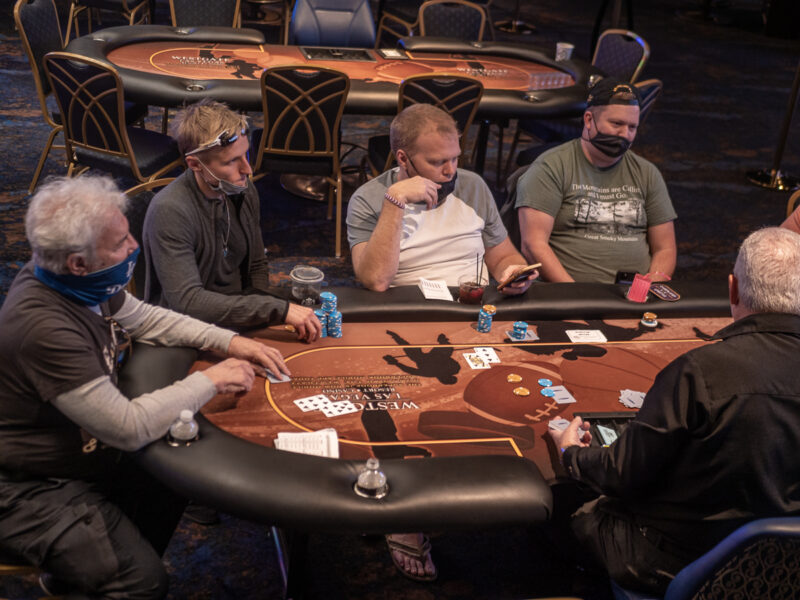
Super Stud Hi-Low, or Super Stud/8 as it is often written, has long been one of my favorite poker games, so I’m pleased to see it growing in popularity. Regular stud games started to fade thirty years ago, and for good reason. The expert advantage was so high that weak players were slaughtered and never wanted to play again, and strong players quickly grew tired of the game. Holdem offered more action and a better chance for a beginner to win. But super stud fixes many of those problems.
While regular stud games, played for hi only, can be broken down into a fairly simple set of rules that create a solid strategy, stud/8 is much more challenging. And adding the “super” wrinkle to it makes super stud/8 a much more interesting game with many more challenging decisions.
How do super stud games work?
Adding “super” to a stud game means that each player receives four down cards and one up card. If they are going to play the hand, they discard two of the down cards, leaving them with a standard three-card stud hand. Then the hand plays out normally. It seems simple, which is great news for those of us who have worked on the different strategies that are important in super stud games.
It is important to remember to discard two of your four down cards before the first card of fourth street comes out of the dealer’s hand or your hand will be dead. Most players will discard at the same time that they put in the chips to raise or call so that they don’t make a mistake and forget to discard. A good dealer will also make sure that everyone left in the hand has only three cards before they deal the next street.
In most super stud high-low games, the bring-in is on the highest card showing. In regular stud high-low the bring-in is on the low card, but in super stud/8 having a low card is really an advantage, so switching the bring-in to the highest card makes for a better game.
What are the important strategy adjustments in super stud games?
Playing stronger hands seems obvious. A hand that might be playable in a regular stud/8 game, like 7h4s2c, is really quite weak in most situations when you are playing super stud/8. I tell my students that a good basic rule is to only play hands in super stud games that you would be really excited about in the regular, non-super, version.
A hand like Ah2h7h, or 3s4c5c, is quite strong in a normal stud/8 game, especially if your flush draws are live, so these hands are generally playable in super stud/8. Your opponents will have an ace in their hand so often that high hands are usually only playable if they are spectacular. This means KcKh9s may not be playable, especially if there is an ace still to act behind you.
As in any stud game, live cards are very important. And you can sometimes have a bit more information about whether your cards are live. If an opponent calls a raise with the 7c showing, and there are no other clubs dead, it is more likely that they have two low clubs than it would be in a normal stud/8 game. You can use this information if you have a borderline hand like 8c3c2c.
You will also run into rolled up hands quite a bit more often, though they are still fairly rare, and you will run into a pair of aces much more often. An opponent who raises with an ace showing will have an ace in the hole with a much higher frequency than you may be used to in normal stud games.
Strategy also changes on later streets in super stud games
Remember that your opponent started with a much stronger, and probably coordinated, hand in super stud. If they catch two cards that might give them a straight or a flush, they are much more likely to have that big hand in a super stud game than in regular stud. And if they catch multiple low cards, they almost always have made a low or a good low draw and a pair.
Even more important, when an opponent raises fifth or sixth street in a super stud game, they almost always have a strong hand, and they will have a super strong hand fairly often. If they have three diamonds showing, you are usually facing a flush. If their board is XX 5648 they usually have a good low and a straight. In a regular stud/8 game, an opponent with that board might have a weak low hand and a pair, but in super stud/8 they will usually have a monster.
An extra tell to watch for
Because players don’t want to risk having their hand declared dead because they forgot to discard, they will often get ready to discard their two cards before it is their turn. If a player to your left is changing the order of their cards, separating out two cards, or if they are clearly not concerned with moving the cards around, it can be a strong indicator about whether they are going to play the hand.
If you watch the two or three players to your left, you will probably pick up a discard tell on at least one of them. If this tell indicates that they are going to play, you should fold some borderline hands. If it indicates that they are going to fold, then you may be able to play a few extra borderline hands.
Why super stud games are so great
I play poker for money. Much of my living for the last 23 years has been earned at the tables. And super stud games are just more profitable. They are a little more interesting, sure, but I mostly love them because people play so badly.
The typical mistake for new players in almost any game is that they are too loose and too passive. Players who play a few too many hands in normal stud games will play way too many hands in super stud games, and then go to a showdown with them much too often.
Starting with five cards is enough to give a loose player an excuse to play almost any hand, and the fact that they can mix them up at the end and claim to have started with different hole cards means that they are rarely going to be embarrassed by showing down a weak starting hand.
Inexperienced players may know that they should have a stronger starting hand in super stud variants, but by fifth street they have usually forgotten that their opponents will have stronger hands and that they will need stronger hands to call or raise with. Seeing a player hold on to two pair they made on fifth street against a scary board, only to be shown a low straight or flush, is standard in lower limit super stud/8 games.
This makes drawing hands even better for strong players because if they make a monster there will be a weak player there to pay them off. Waiting for a hand like 345 or Ah2h6h can seem awfully tight, but when you get one of those hands you can usually win a big pot against someone who started with a weak holding that has trouble catching up.
Weak players will also get themselves into trouble with a pair of aces quite often. They have trouble folding even when your board gets scary, and if they make two pair they can never let it go. Don’t be that player. Aces are playable on third street, but if they don’t improve and your opponent is catching perfect cards, it may be best to fold on fifth street rather than pay three big bets to find out that you were drawing almost dead.


